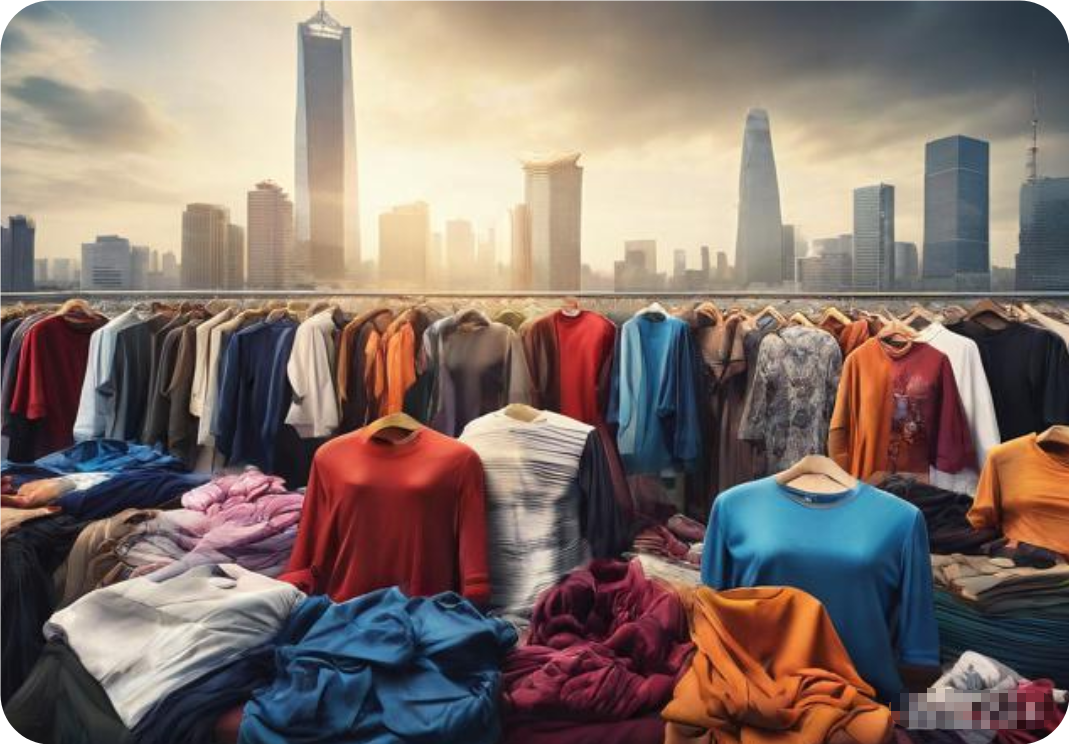In The Context Of The Turbulence Of The International Economic Environment And The Tariff War, The Textile And Clothing Industry Seeks Strategies To Break Through The Dilemma
one The chaotic state of the international environment, and the tariff policy triggered the reshaping of the global economic order
At present, the global economy is facing the most drastic reconstruction of order since World War II. The "reciprocal tariff" policy implemented by the Trump administration of the United States in April 2025 has become the key factor that triggered the reshaping of this order. According to the list released by the U.S. Department of Commerce, China's textiles and clothing face 34% tariffs, while Southeast Asian countries such as Vietnam and Cambodia are subject to 46% and 49% tariffs respectively. This policy has a direct impact on the global textile supply chain - Vietnam, as the core production base of Nike, Lulu Lemon and other brands, accounts for 37.98% of its exports to the United States, and the cost of a single sports shoe may rise by $18 after the imposition of tariffs. At the same time, Mexico, Indonesia and other emerging markets have also joined the ranks of the tariff war. Mexico has imposed a 35% tariff on 138 categories of textiles, and Indonesia has implemented a three-year safeguard tariff on imported carpets.

This tariff war is essentially a redistribution of the power structure of the global industrial chain. According to the data of the World Trade Organization, the growth rate of global textile and clothing exports will decline to 1.2% in 2024, while China's exports to the traditional markets of the United States and Europe will decline by 17.2% compared with the peak in 2010. However, it is worth noting that China still has "potential tariff advantages" in such subdivided fields as knitting and chemical fiber. For example, after the United States imposed 46% tariffs on Vietnam, China's chemical fiber products may expand their market share by virtue of the cost advantage of the whole industrial chain.
2、 The dilemma facing the industry: short-term pain and long-term transformation game
1. The double pressure of overcapacity and shrinking demand In January and February 2025, China's textile and clothing exports fell 4.5% year on year, of which clothing exports fell 6.9%. The utilization rate of global textile capacity has dropped below 75%, while the new capacity of Vietnam, Bangladesh and other countries is still releasing. On the consumer side, the US consumer confidence index fell to 92.9 in March, a new 12 year low, and the willingness to consume non essential goods continued to be depressed. Keqiao Textile Index shows that in March 2025, the textile price index dropped 1.33% year on year, and the market showed a vicious circle of "trading price for quantity".

2. The paradox of supply chain transfer Although enterprises accelerate the transfer of production capacity to Southeast Asia, the tariff policy makes this strategy face the risk of failure. For example, the comprehensive cost advantage of Vietnamese textile enterprises was weakened by the 46% tariff, and some orders began to flow back to China. What is more serious is that alternative markets such as India and Mexico also face tariff barriers of 26% and 35%, and the global supply chain is in a dilemma of "nowhere to move".
3、 Double cycle strategy: balance between policy dividend and implementation challenge
1. Structural opportunities in the domestic demand market According to the data of the China Textile Industry Federation, in 2024, the domestic consumption promotion policy will drive the retail sales of clothing above the designated size to increase by 3.3%, and the proportion of online clothing consumption of physical goods will increase to 28%. Through the full chain integration of "planting spinning dyeing clothing", Xinjiang's cotton industry chain will achieve an output value of 1.627 billion yuan in 2024, up 44.44% year on year. However, the domestic demand market still faces problems such as low brand concentration and insufficient high-end supply. The market share of domestic brands in the price band above 500 yuan is less than 30%.
2. The breakthrough path of the international market cross-border e-commerce has become a new growth pole. In 2024, China's textile and clothing cross-border e-commerce exports will exceed 500 billion yuan, accounting for 16.6% of the total industry exports. Jiangsu Sanlian New Materials achieved a compound growth rate of 63.5% in the sportswear market through differentiated fiber technology, and its technology of "homogeneous heterogeneous multi-component elastic polyester fiber" won the second prize in the industry. However, enterprises need to deal with the challenges of imperfect RCEP investment dispute settlement mechanism and weak overseas intellectual property protection.
4、 Industry prospect: deterministic growth in crisis
1. Technological innovation drives value reconstruction Digital transformation has significantly improved efficiency. Jiangsu Hongdou Men's 5G Factory has improved production efficiency by 32% and shortened delivery cycle by 30% through intelligent hanging system. Green technology has broken through the traditional bottleneck. The "low-pressure anhydrous dyeing technology" of Zhejiang Luyu Textile has achieved 100% zero sewage discharge, reduced the operating cost by 5% - 10%, and was selected into the water saving catalogue of the Ministry of Industry and Information Technology.
2. The explosive potential of the subdivided track outdoor sportswear has become the biggest highlight. In 2024, the revenue of Archaeopteryx will increase by 34%, and the retail sales of professional outdoor products in the Chinese market will exceed 80 billion yuan. The silver economy has given birth to new demands. The market size of functional clothing for aging is expected to reach 120 billion yuan in 2025. The "jade cool fiber" developed by Jiangsu enterprises has been applied to clothing for the elderly.

5、 Corporate coping strategy: building a resilient ecosystem
1. The "triple jump" layout of the supply chain is regionalized: build a "tariff depression" production base in Southeast Asia and Central and Eastern Europe, and use the RCEP tariff reduction policy. For example, Zhejiang Xin'ao Textile integrates the cashmere industry chain in Ningxia and radiates the Central Asian market through cross-border e-commerce.
2. Intelligent: AI scheduling system is introduced to reduce the order response speed from 45 days to 15 days. Through the "trinity" design team and real-time data system, ZARA can complete the design and launch within two weeks.
3. Greenization: H&M promoted the construction of cooperative factories into "family friendly enterprises". After the implementation of flexible working system, the turnover rate of Jiangsu Maoyuan Clothing fell by 56.7%, and the proportion of female supervisors increased to 78%.
6、 "Two wheel drive" of technological innovation
1. Material revolution: develop bio based fibers and degradable fabrics, and Shandong enterprises will integrate jade nanoparticles into fibers to achieve sustainable cooling function.
2. Process breakthrough: promote digital printing, waterless dyeing and other technologies, and Shaoxing printing and dyeing enterprises reduce the use of chemicals by 30% through the intelligent dye distribution system.

7、 "Four dimensional matrix" for market expansion
1. B-end: jointly build a joint laboratory with international brands to participate in the formulation of industry standards. For example, Nike has set up a zero carbon smart logistics park in China to realize the localized supply of 80% of its products.
2. C end: "Guochao IP" is built through platforms such as Tiaoyin and Xiaohongshu, and the online sales of the down jacket co branded by Bosideng and the Forbidden City have exceeded 500 million yuan.
3. G end: undertake government orders and participate in the "Belt and Road" textile industry demonstration project. Xinjiang Korla Textile Park has attracted 28 enterprises to settle in, forming a 10 billion level industrial cluster.
4. New scene: the layout of ice and snow economy and the virtual clothing of the Yuan universe, Li Ning launched the "digital collection" clothing, with a single quarter sales growth of 120%.

To sum up, the editors of World Service Network believe that the textile and clothing industry is undergoing the transformation of "cocoon breaking and rebirth" in the context of the tariff and order reconstruction. Enterprises need to respond to uncertainty with "strategic focus+tactical flexibility": in the short term, they will resist the impact through regionalization of supply chain and technology greening, in the medium term, they will rely on digital transformation and deep cultivation of market segments to enhance added value, and in the long term, they will build a global competitiveness of "technology brand ecology" trinity. Just as Zhejiang Lvyu Textile has spent 16 years researching and developing zero sewage discharge technology, the bright future of the industry belongs to those enterprises that stick to innovation in chaos and prepare for development in dormancy.
- Related reading

IP Strategy Of Textile And Clothing Industry: From Symbol Competition To Competition For Cultural Assets
|
Tariff War: How Long Can The Textile And Clothing Enterprises Exporting To The United States Survive After Tax Increases
|- market research | Three Ways Of Meeting: Conspiring For A New Path Of High-Quality Development Of Assault Suit
- Pregnant baby | Industrial Cluster: Zhili Town Is The Main Production Place Of Children'S Clothing In The World
- Commercial treasure | AI Meets Fashion, China'S Clothing Industry Opens "Fun" And "Beauty"
- Shoes and clothing technology | Embrace AI, Baigou Bags "Sell Globally"
- Listed company | [Stock Market Express] Lilang Men'S Clothing Releases 2024 Annual Performance Announcement
- Industry stock market | Focus On The Domestic Top Women'S Fashion Winners And Release The 2024 Annual Performance Announcement
- Listed company | Industry Stock Market: Lucie Released The 2024 Annual Report, And The Performance Declined
- Mall Express | Taobao Women'S Shoes Sales Number One Su Yinyin: Analysis Of Ecological Growth Path
- Regional policy | The Foreign Trade Service Center Of Shishi International Trade City Was Officially Inaugurated To Help Shishi Textile And Clothing "Go To Sea With High-Quality Products"
- Business management | Xia Lingmin, Secretary General Of China Textile Industry Federation, And His Delegation Went To Fujian For Research
- Three Ways Of Meeting: Conspiring For A New Path Of High-Quality Development Of Assault Suit
- Industrial Cluster: Zhili Town Is The Main Production Place Of Children'S Clothing In The World
- AI Meets Fashion, China'S Clothing Industry Opens "Fun" And "Beauty"
- Embrace AI, Baigou Bags "Sell Globally"
- [Stock Market Express] Lilang Men'S Clothing Releases 2024 Annual Performance Announcement
- Focus On The Domestic Top Women'S Fashion Winners And Release The 2024 Annual Performance Announcement
- Industry Stock Market: Lucie Released The 2024 Annual Report, And The Performance Declined
- Taobao Women'S Shoes Sales Number One Su Yinyin: Analysis Of Ecological Growth Path
- The Foreign Trade Service Center Of Shishi International Trade City Was Officially Inaugurated To Help Shishi Textile And Clothing "Go To Sea With High-Quality Products"
- Xia Lingmin, Secretary General Of China Textile Industry Federation, And His Delegation Went To Fujian For Research


